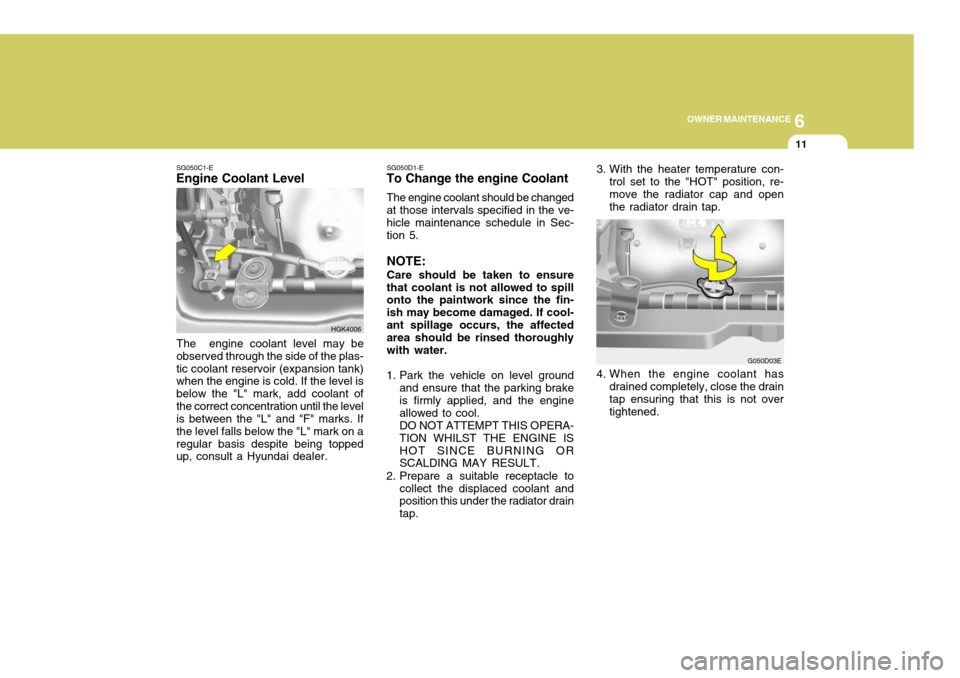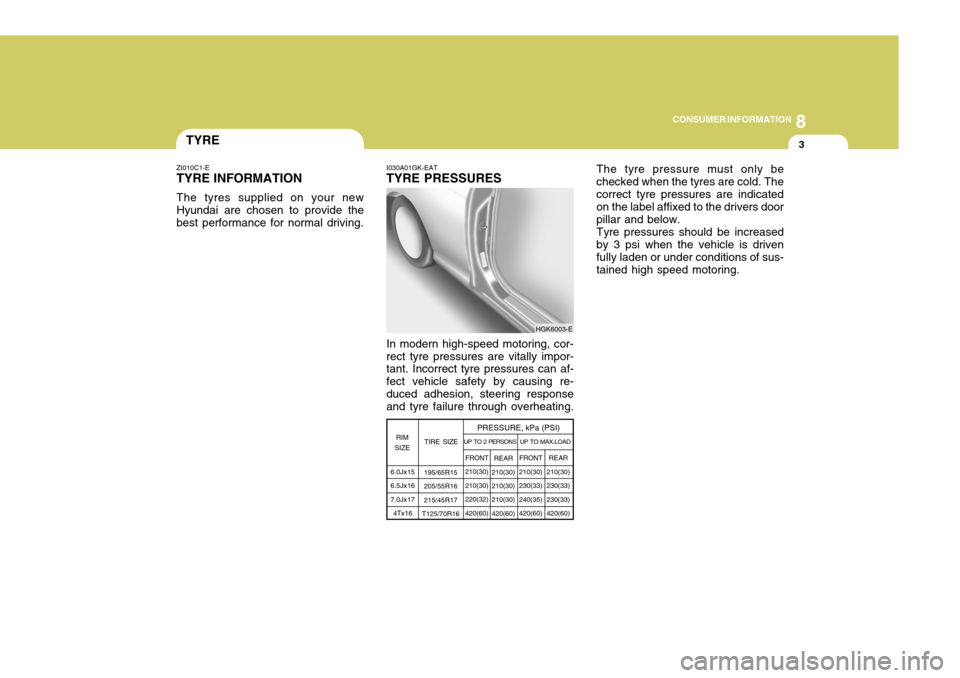2004 Hyundai Coupe ESP
[x] Cancel search: ESPPage 337 of 389

6
OWNER MAINTENANCE
11
HGK4006
SG050C1-E
Engine Coolant Level
The engine coolant level may be
observed through the side of the plas- tic coolant reservoir (expansion tank) when the engine is cold. If the level is below the "L" mark, add coolant ofthe correct concentration until the level is between the "L" and "F" marks. If the level falls below the "L" mark on aregular basis despite being topped up, consult a Hyundai dealer. SG050D1-E
To Change the engine Coolant
The engine coolant should be changed at those intervals specified in the ve- hicle maintenance schedule in Sec- tion 5. NOTE: Care should be taken to ensure that coolant is not allowed to spill onto the paintwork since the fin- ish may become damaged. If cool-ant spillage occurs, the affected area should be rinsed thoroughly with water.
1. Park the vehicle on level ground and ensure that the parking brake is firmly applied, and the engine allowed to cool.DO NOT ATTEMPT THIS OPERA-TION WHILST THE ENGINE ISHOT SINCE BURNING OR SCALDING MAY RESULT.
2. Prepare a suitable receptacle to collect the displaced coolant andposition this under the radiator drain tap. 4. When the engine coolant has
drained completely, close the drain tap ensuring that this is not over tightened. G050D03E
3. With the heater temperature con-
trol set to the "HOT" position, re-move the radiator cap and open the radiator drain tap.
Page 368 of 389

6OWNER MAINTENANCE
42
PROTECTED COMPONENTS
Generator(1.6L/2.0L) BCM BOX(Tail lamp relay,Power connector,Fuse(2,7,12,13,19,20,24))Condenser fan relayRadiator fan relayEngine control relay, Fuel pump relay, A/T control relay, Generator,ECM(1.6L/2.7L),PCM(2.0L) Ignition switch,Start relayABS/ESP control module,ESP Air bleeding connectorABS/ESP control module,ESP Air bleeding connectorBlower relayInjector Oxygen sensor,Camshaft position sensor, Idle speed control actuator DRL control moduleFront fog lamp relayTCM(2.7L),ECM(2.7L/1.6L)Horn relay,A/C relay Head lamp relay(High) Head lamp relay(Low)
FUSERATING 120A50A 30A30A 30A 30A 40A40A30A 15A 10A15A15A10A15A 15A 15A
DESCRIPTION
BATTBATT
COND RAD ECU
IGN
ABS 1 ABS 2
BLOWER INJ
SNSR DRL
F/FOG ECU
HORN,A/CON H/LP (HI)
H/LP (LO)
Page 370 of 389

6OWNER MAINTENANCE
44
DESCRIPTIONIG COIL
AMP
B/UP LAMP
A/BAG IND A/BAG
HTD MIR HAZARD
R/WIPER TAIL-RH
F/WIPER A/C SW
RR DEFOG STOP
TAIL-LH A/CON
ECU
CLUSTER
ROOM LP
P/WINDOW
T/GATE IGN
RR FOG C/LIGHT
S/ROOF S/HTR
ABS
AUDIO
PROTECTED COMPONENTS
Ignition coil(1.6L/2.7L), Electronic chrome mirror AMP Back-up lamp switch,Transaxle range switch,Cruise control module,Stop lamp switch Instrument cluster (A/BAG IND.) SRS control module Mirror defogger Hazard relay Rear wiper motor,Rear intermittent wiper relay Right tail lamps,Glove box lamp Front wiper motor,Front wiper relay Blower relay,Blower motor Defogger relay Stop lamp switch,Burglar alarm horn relay,Folding/Unfolding relay Left tail lamps A/C control module, Blower relay ECM, Multi gauge unit, TCM, Vehicle speed sensor Instrument cluster (Power), Per-excitation resister, DRL Control module,Generator Room lamp,Clock,Audio,Data link connector,Multi gauge unit Power window relay Trunk lid switch AQS sensor,Head lamp relay,DRL Control module Rear fog lamp Cigarette lighter,Outside mirror switch Sunroof,Power door lock/Unlock relay Seat warmer ESP/ABS control module Audio,Digital clock
FUSERATING
20A20A 10A 10A 15A 10A 10A 15A 10A 20A 10A 30A 15A 10A 10A 10A 10A 10A 30A 15A 10A 10A 15A 15A 20A 10A 10A
Page 373 of 389

7
EMISSION CONTROL SYSTEMS
3CATALYTIC CONVERTOR
SH020A1-E Hyundai Coupe models are fitted with catalytic convertors which requirespecial operating considerations. The catalytic convertor serves to oxidize certain noxious elements of the ex-haust gases leaving the engine to reduce the level of pollutants emitted from the vehicle and, provided thatcare is exercised to prevent damage, the catalyst will operate efficiently for the life of the vehicle. It is of the utmost importance that the following information is read and un- derstood by the vehicle operator inorder to prevent operational problems arising from damage to the catalyst. Damage to the catalyst will result if contamination occurs through the useof leaded fuel. Whilst the vehicle is fitted with a reduced diameter filler neck to prevent charging of the fueltank with a leaded fuel pump nozzle, it is possible that the use of funnels or jerry cans will permit leaded fuel to beintroduced into the fuel tank.The catalyst is intolerant of unburntfuel and therefore if an engine misfirecondition exists, damage to the cata- lyst will occur. It is imperative that if a misfire condition develops, the ve-hicle is immediately presented to a Hyundai dealer for rectification. Simi- larly, the practice of certain ignitionsystem diagnosis procedures which involve inducing a misfire (cylinder power balance tests for example) mayresult in catalyst damage.For these reasons, it is advisable thatthe exhaust gas emission be tested at each routine service with a gas analyzer having a Hydrocarbon mea-suring facility to ensure continued re- liability of the catalyst. Push or tow starting of the vehicle is to be avoided since unburnt fuel may be enter the catalyst and result in
Catalytic Converter
HGK5061 damage. (Note, it is impossible to push or tow start a Hyundai modelequipped with fuel injection since the fuel pump safety interlock will prevent the pump from operating under theseconditions).Operation of the catalyst involvesextremely high temperatures beingattained within the catalytic conver- tor, and although the convertor is fitted with heat shields, it is importantthat the vehicle is not parked over combustible or volatile material which may result in fire.If the above precautions are not ad-hered to and the catalyst becomesinoperative, the resultant increase in core temperature will result in a "melt down" where the catalyst core willmelt and subsequently may block the exhaust system. Due to the fragile nature of the cata- lyst element, it is important that dam- age does not occur when the vehicleis raised by means of a garage jack. Care must also be exercised to avoid driving over road hazards or debriswhich may cause damage to the cata- lyst element.
Page 376 of 389

8
CONSUMER INFORMATION
3
I030A01GK-EAT TYRE PRESSURES In modern high-speed motoring, cor- rect tyre pressures are vitally impor- tant. Incorrect tyre pressures can af- fect vehicle safety by causing re-duced adhesion, steering response and tyre failure through overheating. The tyre pressure must only be checked when the tyres are cold. Thecorrect tyre pressures are indicated on the label affixed to the drivers door pillar and below.
Tyre pressures should be increased
by 3 psi when the vehicle is drivenfully laden or under conditions of sus-tained high speed motoring.
6.0Jx15 6.5Jx167.0Jx17 4Tx16 TIRE SIZE
RIM
SIZE PRESSURE, kPa (PSI)
REAR
210(30) 210(30) 210(30)420(60) FRONT
210(30)230(33)240(35) 420(60)
UP TO 2 PERSONS UP TO M
AX.LOAD
REAR
210(30) 230(33)230(33) 420(60)
FRONT
210(30) 210(30)220(32)420(60)
195/65R15 205/55R16215/45R17
T125/70R16
HGK6003-E
TYRE
ZI010C1-E TYRE INFORMATION The tyres supplied on your new Hyundai are chosen to provide the best performance for normal driving.
Page 388 of 389

10INDEX
4
Map light ................................................................... 1-61
Multi functi on switch................................................. 1-50
Multi gauge ............................................................... 1-49
O Odometer .................................................................. 1-46
Outside rearview mirror heater ................................. 1-63
PParking brake ............................................................ 1-64
Pollen filter ................................................................ 1-91
Power steering fluid level ................... ....................... 6-31
Power steering hoses ............................................... 6-30
Power window ........................................................... 1-11
Pre-tensioner seat belt .............................................. 1-28
Protecting your hyundai from corrosion ...................... 4-2
R Rear fog light switch ................................................. 1-54
Rear parcel shelf ....................................................... 1-18
Rear seat entry ......................................................... 1-16
Rear seat pos itions................................................... 1-16
Recommended shift points ......................................... 2-7
Remote fuel filler lid releas e .....................................1-66
Replacing light bulbs ................................................. 6-33
Running in your nero Hyundai .................................... 1-3SScheduled maintenance
.............................................. 5-4
Seat belt pr ecautions................................................ 1-18
Seat belts (3-point type) .... .......................................1-21
Seat cushion height adjustm ent ...............................1-15
Seat warmer .............................................................. 1-15
Service history ............................................................ 5-1
Smooth cornering ...................................................... 2-16
Snow tyres .................................................................. 8-4
Spare tyre ................................................................... 3-5
Sparking plug replacement .......................................6-13
Spectacle case .......................................................... 1-61
Speedometer ............................................................. 1-45
Starting the engine ...................................................... 2-3
Steering wheel freeplay ............................................ 6-26
Steering wheel tilt lever ............................................ 1-69
Stereo sound system ................................................ 1-92
Sun viso r ................................................................... 1-68
Sunroof ...................................................................... 1-59
Supplemental restraint (airbag) system ....................1-30
T Tachometer ............................................................... 1-45
Theft-alarm system ..................................................... 1-8
Trailer or vehicle towing ............................................ 2-18
Electronic stability program (ESP)............................ 2-13
Trailer or vehicle towing tips..................................... 2-21